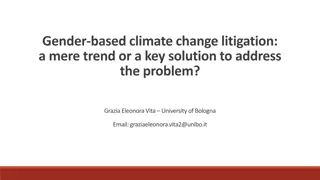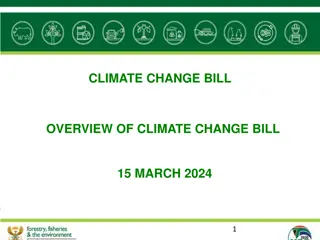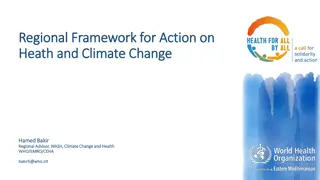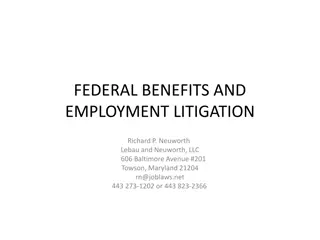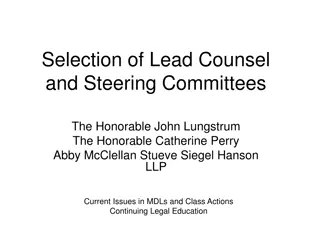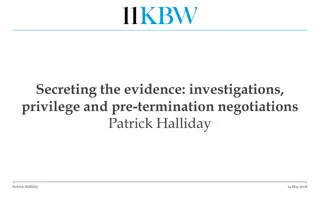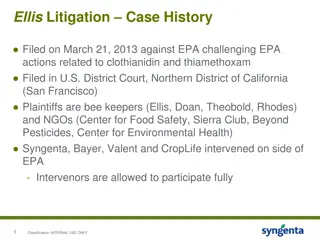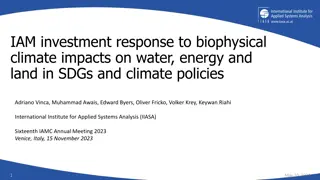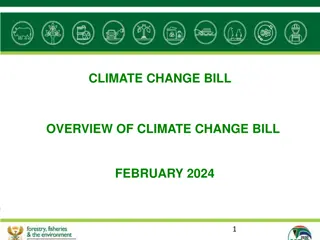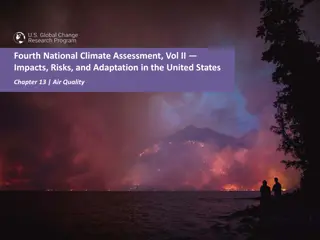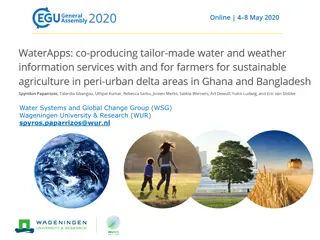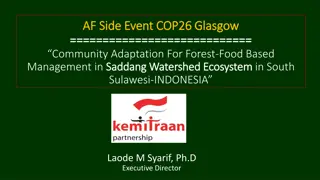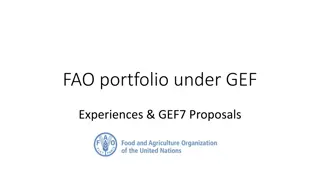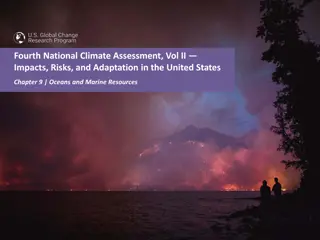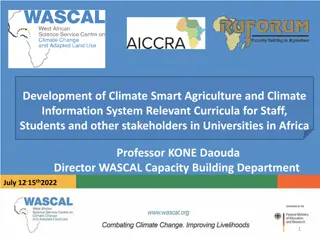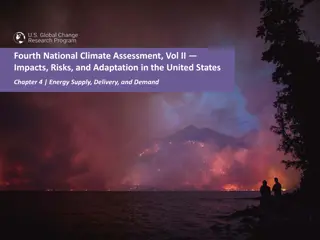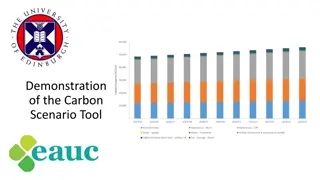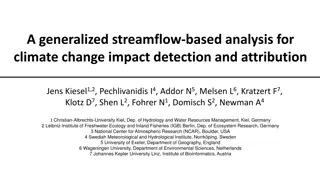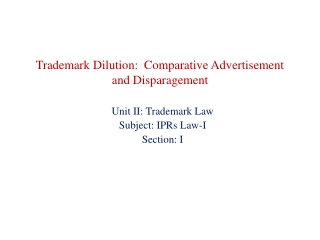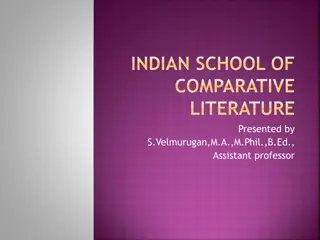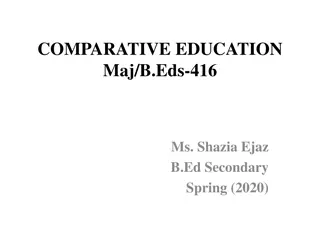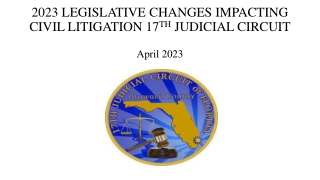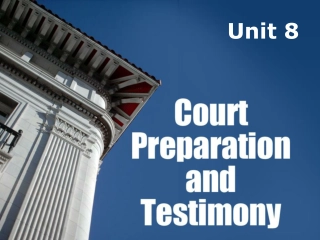Comparative Analysis of Climate Change Litigation
Climate change litigation is a global phenomenon, with a focus on comparative perspectives. This includes a review of litigation waves in the United States, different issues involved, and a European perspective. Legal transplants and the regulatory role of litigation are also discussed, highlighting the importance of addressing climate change through legal mechanisms.
Download Presentation

Please find below an Image/Link to download the presentation.
The content on the website is provided AS IS for your information and personal use only. It may not be sold, licensed, or shared on other websites without obtaining consent from the author. Download presentation by click this link. If you encounter any issues during the download, it is possible that the publisher has removed the file from their server.
E N D
Presentation Transcript
Climate change litigation A comparative law perspective ELI Environmental Law SIG Seminars Thursday 27 May 2021 Prof. Dr. Barbara Pozzo Full Professor of Comparative Law Director, Department of Law, Economics and Cultures
Summary 2 1. Introduction: the interest of climate change litigation from a comparative point of view 2. The wave of climate change litigation in the United States 3. The different issues in climate change litigation (regulatory, Common law, human rights, Public trust) 3. Climate change litigation in Europe: a different perspective: NL, B, CH, EI, F, D, NL 4. The European case: Carvalho & Others 5. Some conclusions
Introduction 3 Climate change litigation is spreading all over the world Very interesting topic for comparative law research International Academy of Comparative Law 2018 (Fukuoka): Comparative Climate Change Litigation National Reports representing all continents Standing, grounds for review, remedies, separation of powers issues
Introduction 4 Legal transplants phenomenon with which we usually identify the process of imitation from one legal system to another of norms, institutions or legal concepts We find the same concept of Public trust in the US (Juliana v. US) and Pakistan (Leghari v. Federation of Pakistan) Though with different backgrounds, interpretation and implementation Particular interests of comparative lawyers: Reasons why transplants happen Impact and Effectiveness
The wave of Climate Change Litigation in the U.S. 5 As an answer to the absence of regulation Climate change litigation aimed at: not only and not so much to get damages arising out of climate change but much more: to get negotiated regulatory policies to introduce financial lever to promote support for governmental policies to provide a mechanism for raising awareness, in a regulatory environment in which policies have not caught up with the problem (yet)
The wave of Climate Change Litigation in the U.S. 6 In the US context climate change litigation in the US context needs to be considered as a reaction from different parts to the government s absence from the scene the use of litigation to address the consequences of climate change might be viewed as a part of the regulation through litigation movement (W. K. Viscusi: Regulation through litigation, 2002)
Different issues of Climate Change Litigation 7 Climate change litigation does not present itself as a monolithic block, or as a homogeneous trend but much more as a series of proceedings started by different parties for very heterogeneous purposes. Sabin Center for Climate Change Law (Columbia University New York) http://climatecasechart.com/climate-change- litigation/
Different issues of Climate Change Litigation 8 THE STATUS OF CLIMATE CHANGE LITIGATION United Nations / Sabin Center https://wedocs.unep.org/bitstream/handle/20.500.1182 2/20767/climate-change- litigation.pdf?sequence=1&isAllowed=y Databases
Different issues of Climate Change Litigation 9 A first and significant group of U.S. climate change cases seek judicial review of administrative decisions. Massachusetts, et al., v. Environmental Protection Agency (2007) Massachussets and other states sued the EPA under the Clean Air Act (CAA) to order the agency to regulate carbon dioxide as a pollutant.
Different issues of Climate Change Litigation 10 Section 202(a)(1) Clean Air Act (CAA), 42 U.S.C. 7521(a)(1): "The Administrator shall by regulation prescribe (and from time to time revise) in accordance with the provisions of this section, standards applicable to the emission of any air pollutant from any class or classes of new motor vehicles or new motor vehicle engines, which in his judgment cause, or contribute to, air pollution which may reasonably be anticipated to endanger public health or welfare."
Different issues of Climate Change Litigation 11 Importance of the background: Under the Clinton Administration, the EPA took the position that it had authority to regulate greenhouse gas emissions under the Clean Air Act. So a group of environmentalists officially asked the EPA to exercise that authority over cars. But in August 2003, under the Bush Administration, the EPA reversed its stance, claiming that it did not have authority to regulate greenhouse gas emissions. And it stated that if it did have the authority, it would choose not to regulate emissions.
Different issues of Climate Change Litigation 12 In 2003, EPA released two statements: 1. The EPA lacked authority under the CAA to regulate carbon dioxide and other GHGs for climate change purposes. 2. Even if the EPA did have such authority, it would decline to set GHG emissions standards for vehicles.
Different issues of Climate Change Litigation 13 Massachussetts and others decided to sue EPA Questions 1. Standing? 2. carbon dioxide is an "air pollutant" causing "air pollution" as defined by the CAA? 3. the EPA Administrator may decline to issue emission standards for motor vehicles on the basis of policy considerations not enumerated in section 202(a)(1)?
Different issues of Climate Change Litigation 14 Supreme Court (5 to 4) 1. standing: YES 2. greenhouse gases fit well within the Clean Air Act s capacious definition of air pollutant 3. the Court remanded the case to the EPA, requiring the agency to review its contention that it has discretion in regulating carbon dioxide and other greenhouse gas emissions. The Court found the current rationale for not regulating to be inadequate and required the agency to articulate a reasonable basis in order to avoid regulation. 2010: EPA released Clean Cars Standards
Different issues of Climate Change Litigation 15 Second group of cases Friends of the Earth, Inc. et al v. Watson et al. (2002) Friends of Earth, other env. associations, some municipalities v. two agencies sued: Overseas Private Investment Corporation (OPIC), the financial institution of the Government of the United States, which promotes US private investments in newly industrialised countries, within the wider framework of US foreign policy promotion Export-Import Bank (Ex-Im) of the United States .
Different issues of Climate Change Litigation 16 WHY? The plaintiffs in this action claimed that the OPIC should start conducting environmental impact assessments regarding its investment procedures, taking into account any possible climate impact of the infrastructures financed by the OPIC itself. Application of National Environmental Protection Act (NEPA)
Different issues of Climate Change Litigation 17 Third group of cases PETITION TO THE INTER AMERICAN COMMISSION ON HUMAN RIGHTS SEEKING RELIEF FROM VIOLATIONS RESULTING FROM GLOBAL WARMING CAUSED BY ACTS AND OMISSIONS OF THE UNITED STATES In 2005, the Chair of the Inuit Circumpolar Conference filed a petition against the United States with the Inter-American Commission on Human Rights (IACHR), an independent body of the Organization of American States
Different issues of Climate Change Litigation 18 The petition alleged that the United States committed human rights violations against the Inuit people of the United States and Canada by failing to restrict GHGs emissions which resulted in climate change and harm to Inuit culture, life, and physical integrity requested a strong stance declaring that the United States is responsible for violations of the American Declaration of the Rights and Duties of Man, Recommending that the United States take measures to limit GHG emissions and protect the Inuit people.
Different issues of Climate Change Litigation 19 The Commission it would not process the petition at present explaining that it was not able to determine, based on the information in the petition, whether the facts alleged would support a finding that the rights protected by the Declaration had been violated.
Different issues of Climate Change Litigation 20 Fourth series of cases: tort cases unquestionable difficulties: Standing Causal linkage Damage assessment Identification of responsible parties Political questions
Different issues of Climate Change Litigation 21 Connecticut v. American Electric Power (2009) eight states and the city of New York brought an action against five important fuel manufacturers, allegedly the main parties responsible for CO2 emissions in the United States lawsuit based in the tort of public nuisance, which can be defined as a behaviour, which obstructs the exercise of rights common to all.
Different issues of Climate Change Litigation 22 the breach of the duty of care against defendants was described as follows: Defendants, by their emissions of carbon dioxide from the combustion of fossil fuels at electric generating facilities, are knowingly, intentionally or negligently creating, maintaining or contributing to a public nuisance global warming injurious to the plaintiffs and their citizens and residents . The suit was never decided at first instance because the Court turned down the claim on the grounds that it was a nonjusticiable political question .
Different issues of Climate Change Litigation 23 Korsinski v. United States EPA (2005) tort of public nuisance Mr Korsinski sued the Environmental Protection Agency for tort of public nuisance. plaintiff s claims, mainly based on the same demands made in Connecticut v. American Electric Power turned down for inability to prove a specific injury
Different issues of Climate Change Litigation 24 Comer v. Murphy the first climate change liability damages suit some citizens victims of hurricane Katrina sued nine fuel manufacturers, thirty-one coal producers and four chemical companies on the basis of the following torts: tort of negligence, unjust enrichment, civil conspiracy, fraudulent misrepresentation, concealment trespass. The Court turned down the claim both at first instance and appeal
Different issues of Climate Change Litigation 25 California v. General Motors Corp. (2006) Attorney General of California started proceedings against General Motors and five other big car manufacturers for tort of public nuisance According to the statistics shown during the trial, the emissions of the cars manufactured by the defendants account for 9% of CO2 emissions worldwide: Defendants know or should have known, and know or should know, that their emissions of carbon dioxide and other greenhouse gases contribute to global warming and to the resulting injuries and threatened injuries to California, its citizens and residents, environment, and economy . The Court turned down the claim both at first instance and appeal
Different issues of Climate Change Litigation 26 In June 2009, the California Attorney General s Office voluntarily dropped its appeal to the Ninth Circuit to review the district court s dismissal of the state s public nuisance lawsuit against six major automobile companies. The withdrawal contained a statement that recent policy changes by the Obama administration indicated progress on certain related issues, specifically an increase in fuel economy standards and EPA s endangerment finding that greenhouse gases pose a threat to public health and welfare.
Different issues of Climate Change Litigation 27 Kivalina v. ExxonMobil Corporation, et al. Tort of nuisance claims monetary damages from the energy industry for the destruction of Kivalina (Alaska) by flooding caused by climate change. The plaintiffs argued that the defendants contribution to global warming through their emissions of carbon dioxide and other greenhouse gasses was substantially and unreasonably interfering with the plaintiffs rights to use and enjoy public and private property in Kivalina.
Different issues of Climate Change Litigation 28 Plaintiffs 1. sought to recover monetary damages for the cost of relocating the entire village as a result of what they describe as defendants past and ongoing contributions to global warming 2. alleged that defendants conspired to suppress public awareness of the link between greenhouse gas emissions and global warming, thereby further contributing to the community s injuries.
Different issues of Climate Change Litigation 29 On 30 September 2009, the US District Court for the Northern District of California granted the defendants motion to dismiss: the case raises nonjusticiable political questions the plaintiffs lack standing.
Different issues of Climate Change Litigation 30 Juliana v. US Public trust doctrine young plaintiffs also on behalf of future generations assert that the federal government violated their constitutional rights by causing dangerous carbon dioxide concentrations defendants actions violate their substantive due process rights to life, liberty, and property, and that defendants have violated their obligation to hold certain natural resources in trust for the people and for future generations.
Different issues of Climate Change Litigation 31 Defendants: the lack of governmental action on climate change discriminated against the youths' generation, since they would be most impacted by climate change but have no voting rights to influence that Three fossil fuel industry groups: the American Petroleum Institute, American Fuel and Petrochemical Manufacturers, and the National Association of Manufacturers initially intervened in the case as defendants, joining the U.S. government in trying to have the case dismissed.
Different issues of Climate Change Litigation 32 Pre-trial hearings: U.S. Magistrate Judge Thomas Coffin. U.S. Department of Justice argued: 1. there was "no constitutional right to a pollution-free environment" 2. the court system was not the proper venue to affect such changes Judge Coffin: 1. ruled in April 2016 recommending that both motions to dismiss were denied 2. Although the case was "unprecedented", it had sufficient merit to continue Judge Aiken: the right to "a climate system capable of sustaining human life" is a fundamental right
Different issues of Climate Change Litigation 33 https://www.ourchildrenstrust.org/juliana-v-us
Climate change litigation in Europe 34 In comparison to the United States, the European experience has taken a very different path: since the late 1980s, the European Union has always wanted to play an increasingly active role in pursuing a coherent environmental and energy policy strictly connected with climate change regulation both at national and international level.
Climate change litigation in Europe 35 Why is climate change litigation then spreading out in the EU? Challenge to the effectiveness of our legislative framework Citizens are tired of very challenging promises that seem not effective Importance of NGOs and environmental association in favoring this process
Climate change litigation in Europe 36 URGENDA Tort law case based on art. 162 Dutch Civil Code ( a person who commits a tort towards another which can be imputed to him, must repair the damage which the other person suffers as a consequence thereof ) Article 21 Dutch Constitution ( It shall be the concern of the authorities to keep the country habitable and to protect and improve the environment ): fundamental right to the environment.
Climate change litigation in Europe 37 Under the due care standard of Dutch tort law the Court tested whether the State fulfilled its duty of care towards its citizens Urgenda brought together all possible legal sources that are relevant when determining what can be expected from a national government in the combat against climate change
Climate change litigation in Europe 38 Legal sources: 1. Art. 2 ECHR positive obligation on States to take appropriate steps to safeguard the lives of those within their jurisdiction, even when these lives are threatened by other (private) persons or activities that are not directly connected with the State, for instance in case of dangerous activities and natural disasters. 2. Art. 8 ECHR requires States to adopt positive measures designed to ensure that environmental degradation does not seriously affect private and family life or the home, which implies also regulating private sector activities, and implementing such measures. 3. Art. 21 Dutch Constitution grants the State extensive discretionary power to flesh out its climate policy, but this power is limited. In case of a high risk of dangerous climate change with severe life-threatening consequences for man and the environment, the State has the obligation to protect its citizens by taking appropriate and effective measures .
Climate change litigation in Europe 39 4. Art. 3(1) UNFCCC, requires parties to the convention to protect the climate system for present and future generations on the basis of equity and common-but-differentiated responsibilities. This means, according to the Court, that future generations cannot be disproportionately burdened with the consequences of climate change Art. 3(3) UNFCCC and Art. 191(2) TFEU: precautionary principle which indicates that States should not postpone taking cost- effective measures to protect the environment until full scientific certainty has been achieved. doctrine of hazardous negligence as developed by the Dutch Supreme Court and in academic literature, which requires the State to exercise due care with its climate policy 5. 6.
Climate change litigation in Europe 40 The Court did not accept the objections put forward by the Dutch State (while agreeing on the seriousness of the problem and the need to take appropriate action): the possible acceptance of the action would have entailed an interference in the discretion of the legislative and executive powers and a breach of the principle of separation of powers the further reduction in Dutch emissions required by the actors should have been considered irrelevant, in view of the fact that the Dutch contribution to global emissions could be considered as minimal
Climate change litigation in Europe 41 The Urgenda case can be considered as a source of inspiration for further litigation in Europe 2015: ONG Klimaatzaak v. Belgio Similar to the Urgenda case in the Netherlands, the Klimaatzaak was brought on the ground of art. 1382 Belgian Civil Code by an organization of concerned citizens arguing that Belgian law requires the Belgian government's approach to reducing greenhouse gas emissions to be more aggressive
Climate change litigation in Europe 42 Klimaatzaak v. Belgium fault of the State should have been acting diligently and reasonably, as a bonus pater familias towards its citizens, in order to avoid the risks linked to climate change, which may occur as damage to health, to property, but also as damage to the general well-being resulting, for example, from the propagation of tropical diseases, or the intensification of heat waves
Climate change litigation in Europe 43 Claimants NGO founded ad hoc by well-known people belonging to the star system ask the Court an injunction against the government to reduce emissions from 42 to 48% by 2025 and to at least from 55 to 65% by 2030. Case still ongoing Final hearing in March 2021. Decision before next summer
Climate change litigation in Europe 44 The Urgenda case is also presented as a source of inspiration in the case proposed in Switzerland Klimaseniorinnen v. Swiss Federal Government However: in this context the requests of the actresses were not based on a violation of neminem laedere, but on a violation of fundamental rights.
Climate change litigation in Europe 45 older women are particularly vulnerable to climate change impacts KlimaSeniorinnen Schweiz (Senior Women for Climate Protection Switzerland) filed a legal request with the authorities claiming that the Swiss authorities are failing to fulfil their duty to protect them as required by the Swiss Constitution and by the European Convention on Human Rights
Climate change litigation in Europe 46 Klimasseniorinnen in 2016 had applied to the federal Council, the federal Department of the atmosphere, the transports, the energy and the communication (DATEC), the Federal Office of the atmosphere (UFAM) and the Federal Office of the energy (SFOE) To tighten climate targets in order to enable the less than 2 C target set by the Paris Agreement to be reached, A target impossible on the basis of the Swiss legislation in force.
Climate change litigation in Europe 47 The case discussed was unsuccessful in front of Swiss courts The association has introduced appeal in the Court of the human rights in Strasbourg
Climate change litigation in Europe 48 Climate Case Ireland Friends of the Irish environment v. the Government of Ireland (2020) The National Mitigation Plan ( the Plan ) 2017 failed to specify the manner in which it is proposed to achieve the national transition objective , as required by the Climate Act 2015. The Government must now create a new, more ambitious National Mitigation Plan that complies with Ireland s national and international climate obligations.
Climate change litigation in Europe 49 Nos Affaire tous 2019 Association Oxfam France Tribunal Administratif of Paris 1) order the State to pay the symbolic sum of EUR 1 in compensation for the moral damage suffered; 2) order the State to pay the symbolic sum of 1 euro for ecological damage; 3) order the Prime Minister and the competent ministers to put an end to all the failures of the State to its obligations in the fight against climate change or to remedy its effects;
Climate change litigation in Europe 50 3 February 2021: The Tribunal Administratif condemns the State to comply with all the demands made by Oxfam


